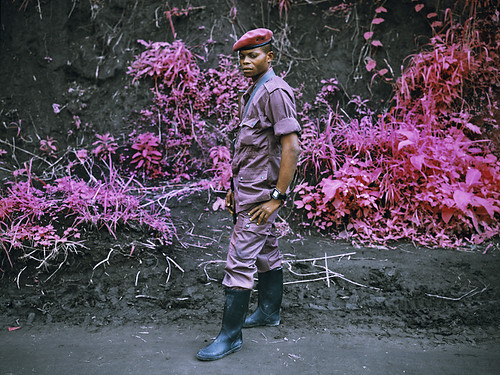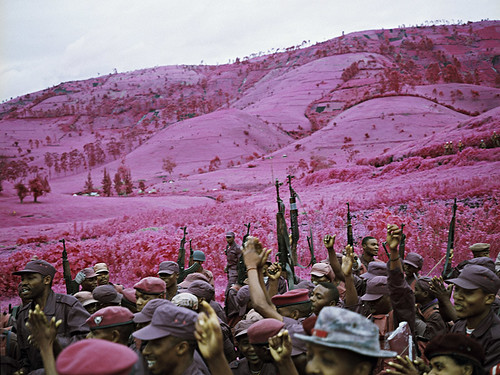

British Journal of Photography
March 25 2010
Richard Mosse: La Vie En Rose
by Olivier Laurent
Ask Richard Mosse what first fascinated him about the Congo and he'll give you a long list. "Joseph Conrad. Tin Tin. The Rumble in the Jungle. The Belgian colonial legacy. The beer. The Ebola virus. A country the size of Western Europe with less paved roads than Ireland. The ‘bulletproof' Mai Mai warriors. A conflict so pathologised that it is well past the point of human comprehension."
But it's the latter reason that led the Irish-born photographer to use Kodak's Aerochrome film. Discontinued last year, the film is particularly sensitive to infra-red light, rather than to the usual visible spectrum of colours registered by traditional film. Since foliage reflects infra-red while buildings don't, the US Army used it during the Vietnam War to detect and reveal hidden soldiers. "I wanted to export this technology to a harder situation, to up-end the generic conventions of calcified mass-media narratives and challenge the way we're allowed to represent this forgotten conflict," says Mosse. "I wanted to confront this military reconnaissance technology, to use it reflexively in order to question the ways in which war photography is constructed."
Mosse was first inspired to use the film after seeing the work of Florian Maier-Aichen. "This German artist rejects the influence of the Kunstakademie Düsseldorf and the Becher school to embrace a kind of Romantic exploration of the landscape of the American West," says Mosse. "I was moved by the beauty of this work, and wondered whether he used colour infra-red film to compose certain images. I'm not sure whether he actually did, but I got excited by the technology, which is considered to be a kind of photographic taboo – thou shalt not cross-process; thou shalt not use colour infra-red film."
While Mosse refuses to reveal where he got the discontinued film - "I could tell you but then I'd have to kill you," he jokes – up until February, a small company in Germany supplied it in the 120 medium format by cutting it down from a large roll stock. However, even that supplier has now run out of the film, BJP understands. But this setback hasn't deterred Mosse from his continued interest in Congo and infra-red technology. The 30-year-old photographer plans to go back next year with cinematographer Trevor Tweeten, with whom he's worked on previous projects.
"We plan to shoot IR Red One video. That involves sending the Red One camera back to the factory where the OLPF filter will be removed from the digital sensor." The result "will be quite extraordinary and very different to the old Aerochrome stock," he says. "It will be a kind of blown-out monochrome palette. We've actually shot infra-red before in Iraq, where Trevor repurposed his Zeiss lens to peer through a US Army IR goggle eyepiece. The result was this nightmarish green-and-black palette, rather like the old DOS interface for anyone old enough to remember computer screens before Windows and the Mac Classic."
However, he says, "the IR we will shoot in Congo will probably look a lot different, rather like the moment an atom bomb detonates. The world will seem shadowless, like a breathless high-noon desert landscape, yet we'll be beating through the jungle shadows."
www.richardmosse.com
